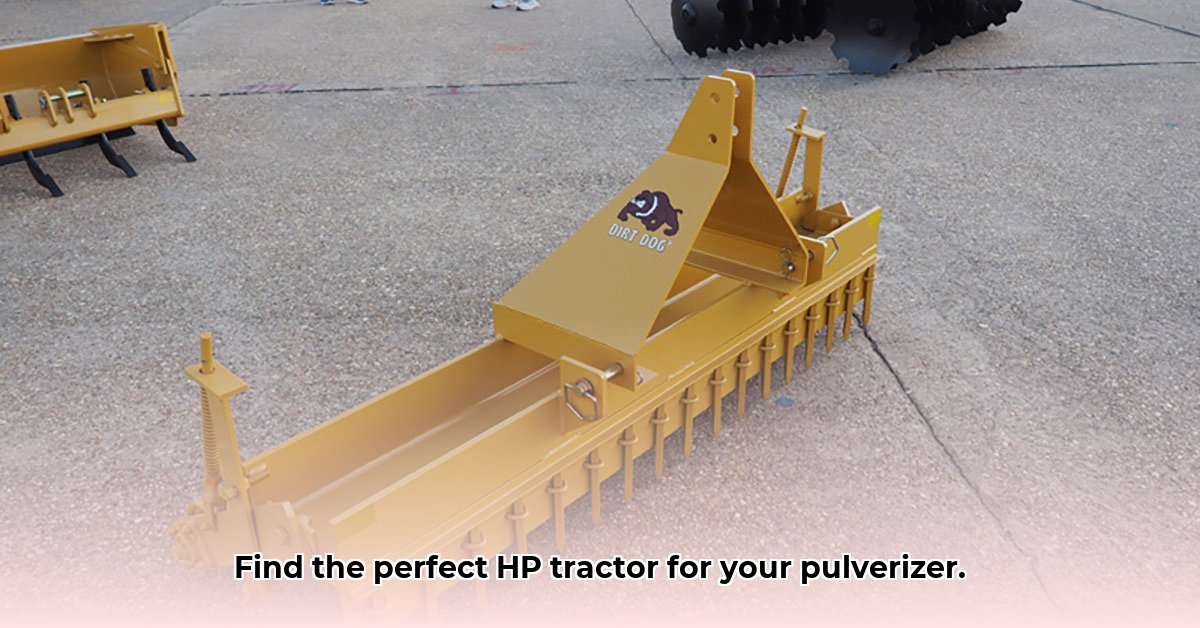
Choosing the right tractor for your soil pulverizer is crucial for efficiency and longevity. Underpowering your equipment leads to wasted fuel, reduced productivity, and increased wear and tear. Overpowering it means unnecessary expense. This guide provides a step-by-step approach to determining the optimal horsepower for your needs. For more information on tractor horsepower, see this helpful resource on Ford 3600 tractor horsepower.
Factors Affecting Horsepower Needs
Several key factors influence the horsepower required to effectively operate a soil pulverizer. Understanding these factors is the first step in making an informed decision.
Pulverizer Size and Working Width
Larger pulverizers cover more ground per pass, demanding more horsepower. The manufacturer's specifications will indicate the recommended horsepower range for their machine. A 12-foot pulverizer will naturally require far more power than a 6-foot model.
Soil Type and Compaction
Soil type significantly impacts horsepower needs. Clay soils, known for their high compaction, require considerably more power than sandy or loamy soils. Consider the soil's consistency: is it loose and easily worked, or compacted and resistant? Compacted soils demand significantly more power to break up.
Terrain and Slope
Flat, level fields require less horsepower than hilly or sloped terrain. Steeper slopes increase the load on the tractor, demanding more power to maintain traction and prevent slippage. The steeper the incline, the more power you'll need.
Pulverization Depth
Deeper pulverization requires more power. Shallow passes need less horsepower than deeper ones that work the soil to a greater depth. The depth of tillage directly correlates to power requirements.
Additional Attachments
Adding implements such as seeders or fertilizer spreaders increases the overall load, requiring additional horsepower. Each attachment adds to the overall demand on the tractor's power.
Estimating Horsepower Requirements: A Step-by-Step Process
Use this step-by-step process to estimate your horsepower needs:
Check Pulverizer Specifications: Begin by consulting your pulverizer's manual for the manufacturer's recommended horsepower range. This is your baseline.
Assess Soil Conditions: Determine your soil type (sandy loam, clay, etc.) and its compaction level. Heavy clay requires significantly more power.
Evaluate Terrain: Categorize your fields (flat, gently rolling, steep). Steeper slopes demand more horsepower.
Determine Pulverization Depth: Specify the depth to which you intend to pulverize the soil. Deeper pulverization increases the horsepower requirement.
Account for Attachments: Add any additional implements to the equation, as they will increase the total power demand.
Add a Safety Margin: Always add 10-20% to your calculated horsepower to account for unexpected challenges (e.g., unusually hard soil, wet conditions). This buffer ensures sufficient power reserve.
Example: A medium-sized (10-foot) pulverizer operating on silty loam soil with moderate slopes and a moderate depth of pulverization might require a tractor in the 75-100 HP range. Adding a seeder would increase this need.
Choosing Your Tractor: Beyond Horsepower
While horsepower is pivotal, other factors matter:
Fuel Efficiency: A fuel-efficient tractor reduces operational costs over time. Look for tractors with good fuel economy ratings.
Maneuverability: Choose a tractor with appropriate size and turning radius for your fields. A more maneuverable tractor is more useful in tight spaces.
Maintenance: Easy-to-maintain tractors minimize downtime and costs.
Comfort and Features: Consider operator comfort, features (e.g., power steering, air conditioning), and ease of operation.
Maintenance and Optimization
Regular maintenance is crucial for both your tractor and pulverizer. This includes lubricating moving parts, maintaining blade sharpness (dull blades significantly increase power demands), and scheduling routine inspections. Regular maintenance prolongs equipment life and optimizes efficiency.
Troubleshooting Common Issues
If your tractor struggles, consider these possibilities:
Insufficient Horsepower: You might need a more powerful tractor. Re-evaluate your horsepower calculations considering all the factors outlined above.
Dull Blades: Dull blades increase the demand on the tractor. Sharpen or replace them routinely.
Soil Conditions: Difficult soil conditions (extreme wetness or dryness) may require adjustments to the pulverization depth or alternative tillage methods.
Conclusion
Matching your tractor's horsepower to your soil pulverizer is vital for optimal performance and efficiency. Use this guide to estimate your needs, but remember that consulting with your equipment dealer is highly recommended for personalized advice. They can help tailor a solution to your specific farm and soil conditions.
Key Takeaways:
- Soil type and compaction are major factors affecting power needs.
- Pulverizer size and depth of tillage heavily influence horsepower requirements.
- Terrain greatly impacts the tractor’s power demands.
- Always include a safety margin in your horsepower calculations.
- Consider factors beyond horsepower when choosing your tractor.